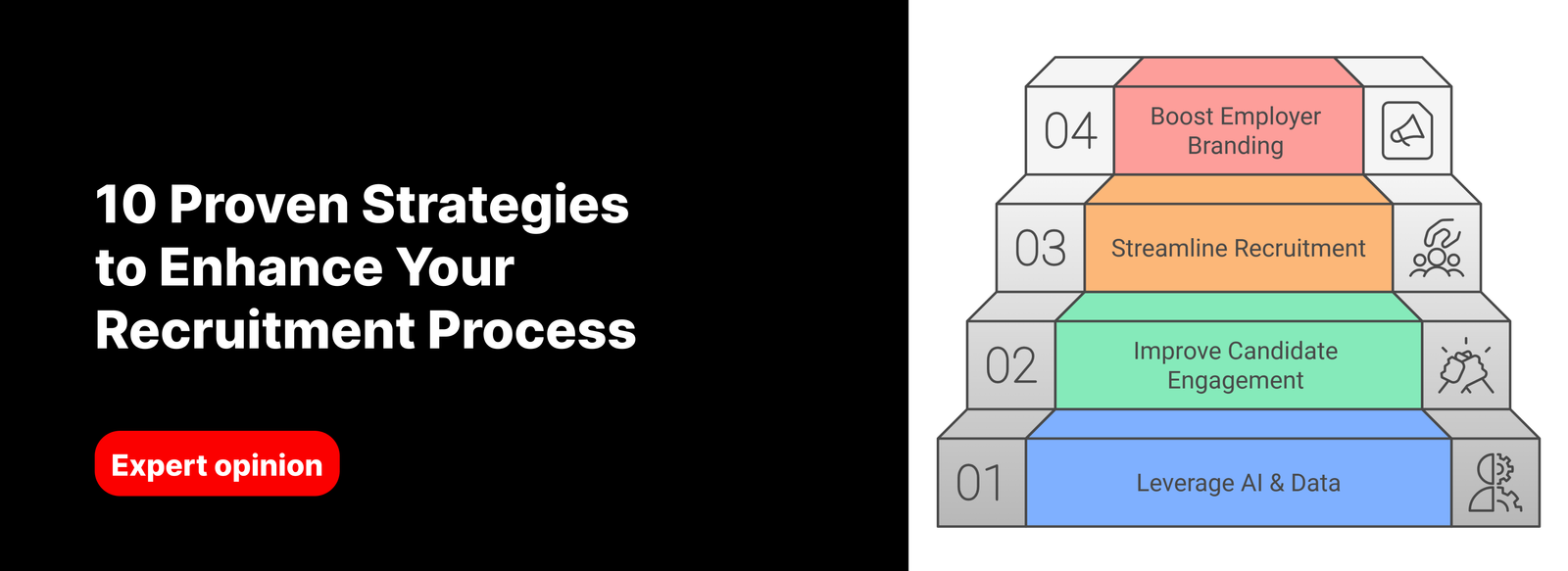8, Dec, 2024(4) | Tayyab Javed

In today’s competitive job market, attracting and retaining top talent requires more than just posting job ads and conducting interviews. To stay ahead, companies need to Enhance Recruitment Process by leveraging technology, data, and innovative strategies. Whether you’re looking to hire faster, improve candidate quality, or streamline onboarding, enhancing your recruitment process is key to building a thriving workforce.
This guide explores:
Let’s dive into the top strategies to enhance your recruitment process and take your hiring to the next level.


Artificial intelligence (AI) has revolutionized the recruitment process by enabling better candidate-job matching. AI-powered tools analyze resumes, skills, and job requirements to identify the best-fit candidates efficiently.
Example: Tools like LinkedIn Recruiter or Workable leverage AI to recommend candidates that align with job requirements, saving time and effort.
Data is the backbone of a successful recruitment process. By analyzing recruitment metrics, companies can identify bottlenecks, improve strategies, and ensure optimal hiring outcomes.
Pro Tip: Use Applicant Tracking Systems (ATS) like Greenhouse or Lever to collect and analyze recruitment data for actionable insights.
A clear and compelling job description attracts the right candidates while setting expectations upfront. Use concise language and include essential details about the role, responsibilities, and company culture.
Example: A well-crafted job posting for a software engineer might include phrases like “proficient in Python and JavaScript” and “opportunity to work on cutting-edge AI projects.”

A positive candidate experience reflects well on your brand and increases the likelihood of accepting offers. Treat candidates as valued stakeholders in the recruitment process.
Example: Automate communication touchpoints with tools like Recruitee to ensure candidates feel engaged throughout the process.
A structured interview process standardizes how candidates are evaluated, reducing bias and improving hiring consistency.
Pro Tip: Use tools like Interviewer.AI to record and analyze interviews, ensuring consistency and fairness.
Employee referrals are a cost-effective way to source high-quality candidates. Referred candidates often align with company culture and are more likely to succeed in their roles.
Example: A retail company implemented a referral program with cash incentives, leading to a 20% increase in qualified applicants.
Automation tools simplify repetitive tasks, allowing HR teams to focus on strategic activities like building relationships with top candidates.
Benefit: Automation improves efficiency, reduces errors, and enhances candidate experience.
Your employer brand is how potential candidates perceive your company as a workplace. A strong employer brand attracts top talent and boosts retention.
Example: A tech company shared employee stories on LinkedIn, showcasing their inclusive culture and innovative projects, leading to a surge in applications.
The onboarding process sets the tone for a new hire’s experience with your company. A seamless onboarding program ensures employees are productive and engaged from day one.
Example: A financial firm reduced onboarding time by 30% by implementing a digital onboarding platform.

Recruitment is an ongoing process that requires regular evaluation to ensure efficiency and effectiveness.
Pro Tip: Use heatmaps or user behavior analysis tools to identify bottlenecks on your career page.
Optimizing your recruitment process is crucial for attracting top talent, improving efficiency, and building a thriving workforce. By leveraging AI tools, adopting data-driven techniques, and focusing on candidate experience, you can enhance your hiring practices and position your company for long-term success.
Take the first step by implementing one or more of these proven strategies. Your improved recruitment process will not only attract top talent but also retain them, ensuring sustainable growth for your organization.